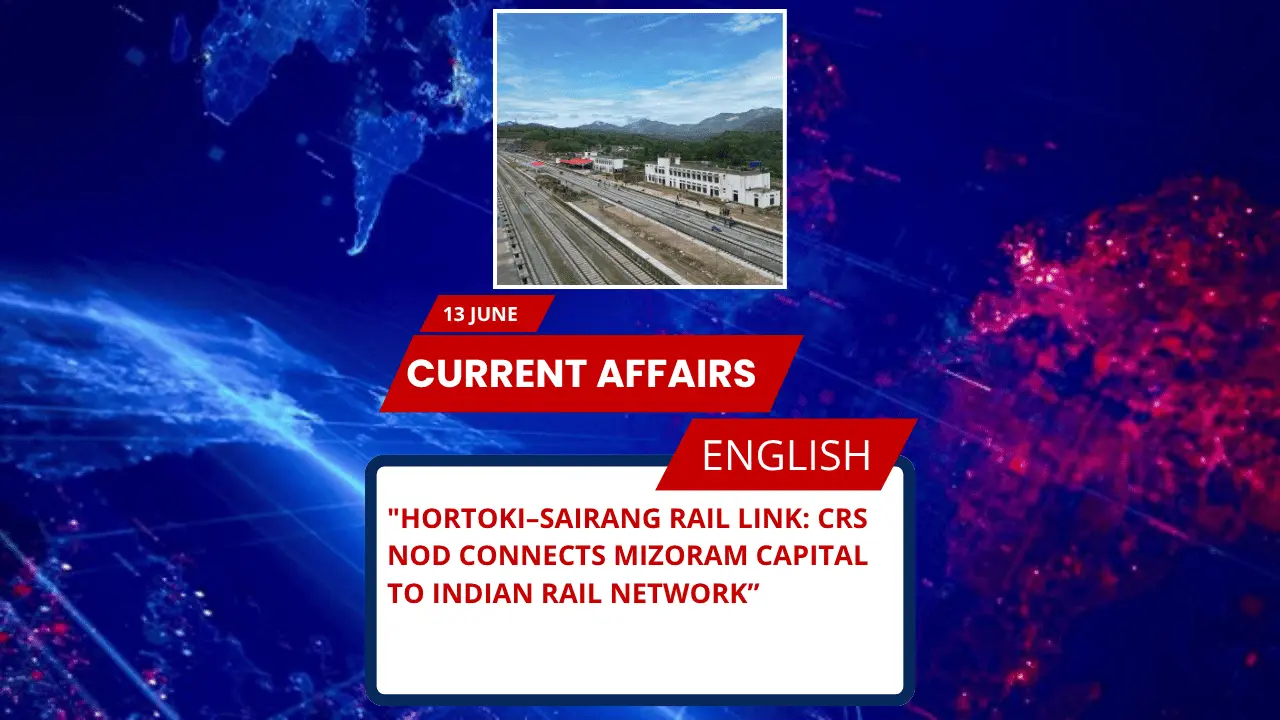
The Commission of Railway Safety (CRS) has approved operations on the Hortoki–Sairang rail line, marking the first-ever railway connectivity of Mizoram’s capital Aizawl to the national rail network. This is a landmark development in the government’s effort to integrate northeastern capitals with the Indian Railways.
Key Points for SSC, UPSC, and Other Government Exams
- Hortoki–Sairang line length: 33.86 km
- Bairabi–Sairang rail project length: 51.38 km
- No. of tunnels in Bairabi–Sairang project: 48 (cumulative length 12,853 m)
- No. of major bridges: 55
- Tallest bridge: Bridge no. 196, 104 m (42 m taller than Qutub Minar)
- Speed limit on the new stretch: 90 kmph
- Final CRS inspection: June 6–10, 2025
- Ministry overseeing CRS: Ministry of Civil Aviation
- Project aim: To connect all northeast state capitals to Indian Railways
- Northeast rail projects (as of April 1, 2024): 18 projects (13 new line, 5 doubling), 1,368 km planned, Rs 74,972 crore cost
- Expenditure till March 2024: Rs 40,549 crore
- Capital of Mizoram: Aizawl
Complete Details of Hortoki–Sairang Railway Line Project
Background and Significance
The Hortoki–Sairang railway line, part of the Bairabi–Sairang New Line Project, has received the green light from the Commission of Railway Safety (CRS). This approval marks the culmination of a critical infrastructure milestone — bringing Aizawl onto the national railway map.
Technical Highlights
The Bairabi–Sairang rail project spans 51.38 km, featuring:
- 48 tunnels with a combined length of 12,853 meters
- 55 major bridges
- 87 minor bridges
- 5 road overbridges
- 6 road underbridges
One of the engineering marvels is Bridge No. 196, standing at 104 metres — surpassing the height of iconic structures like the Qutub Minar by 42 metres.
Final Inspection
The final inspection by CRS Sumeet Singhal was conducted between June 6 and 10, 2025. It included motor trolley and foot inspections followed by a diesel locomotive speed trial. Approval was granted for goods and passenger services at up to 90 kmph.
Broader Vision
The project is part of the Indian Railways’ mission to connect all northeastern state capitals — including Nagaland, Arunachal Pradesh, Manipur, Tripura, Sikkim, and Assam — enhancing integration and development. Rail expansion in Meghalaya remains stalled due to local opposition.
Important Facts About Mizoram
- State: Mizoram
- Capital: Aizawl
- Chief Minister (2025): Lalduhoma
- Governor (2025): Hari Babu Kambhampati
- Major Rivers: Tlawng, Tuirial
- Important National Park: Phawngpui National Park
- Border States: Assam, Manipur, Tripura
- International Borders: Myanmar, Bangladesh
Exam-Relevant MCQs
Q1. The recently approved Hortoki–Sairang railway line will connect which state capital with the national rail network for the first time?
a) Kohima
b) Aizawl
c) Imphal
d) Agartala
Answer: b) Aizawl
Q2. The tallest bridge in the Bairabi–Sairang rail project is how high?
a) 104 m
b) 76 m
c) 62 m
d) 89 m
Answer: a) 104 m
Q3. The Bairabi–Sairang rail project includes how many major bridges?
a) 32
b) 55
c) 48
d) 87
Answer: b) 55
Q4. Under which ministry does the Commission of Railway Safety operate?
a) Ministry of Railways
b) Ministry of Civil Aviation
c) Ministry of Road Transport
d) Ministry of Home Affairs
Answer: b) Ministry of Civil Aviation
UPSC-Style FAQs (Answer Writing Format)
Q1. Discuss the significance of the Hortoki–Sairang railway line for the socio-economic development of Mizoram.
Answer:
The Hortoki–Sairang railway line is of great strategic and socio-economic importance for Mizoram. By connecting Aizawl, the state capital, to the national railway network, it integrates the region into the broader Indian economy. This will enhance the movement of goods, reduce logistical costs, and spur trade opportunities, especially for the agricultural and horticultural produce of the state. The line will also promote tourism by improving accessibility to the scenic landscapes of Mizoram. From a strategic viewpoint, it strengthens connectivity in a border state, aiding national security and disaster response capabilities. Furthermore, this project is aligned with the Government of India’s Act East Policy, fostering closer economic ties with Southeast Asian nations through improved infrastructure.
Q2. What are the major engineering challenges associated with the Bairabi–Sairang rail project?
Answer:
The Bairabi–Sairang rail project posed several engineering challenges due to Mizoram’s rugged and hilly terrain. The construction involved building 48 tunnels and 55 major bridges, including Bridge No. 196 which stands at 104 metres, making it taller than many historic monuments. The region’s complex geology and susceptibility to landslides required advanced tunneling techniques and robust bridge foundations. Weather conditions, particularly heavy rainfall during monsoon, added to the complexity, affecting timelines and necessitating innovative solutions for drainage and slope stability. Despite these challenges, the project showcases India’s growing capability in executing infrastructure works in difficult topographies.
Q3. How does the Bairabi–Sairang railway project align with India’s policy towards the northeast?
Answer:
The Bairabi–Sairang railway project is a key component of India’s broader policy to promote connectivity and integration of the northeastern states with the rest of the country. This aligns with initiatives such as the Act East Policy, which aims to enhance infrastructural links both within the region and with Southeast Asia. The project is part of Indian Railways’ plan to connect all northeastern capitals, thereby improving economic opportunities, regional mobility, and national security. Enhanced rail connectivity helps reduce regional disparities, foster development, and address long-standing grievances of isolation among northeastern communities.







